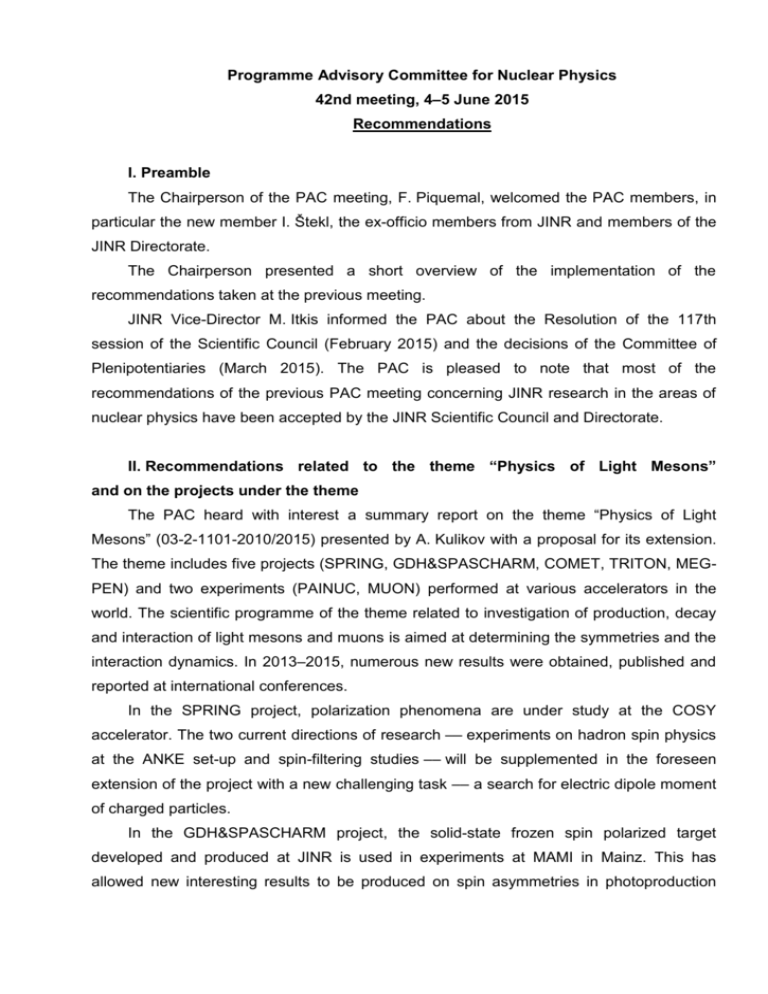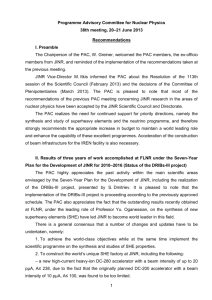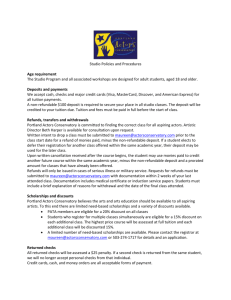Recommendations, 42nd meeting, PAC for Nuclear Physics
advertisement

Programme Advisory Committee for Nuclear Physics 42nd meeting, 4–5 June 2015 Recommendations I. Preamble The Chairperson of the PAC meeting, F. Piquemal, welcomed the PAC members, in particular the new member I. Štekl, the ex-officio members from JINR and members of the JINR Directorate. The Chairperson presented a short overview of the implementation of the recommendations taken at the previous meeting. JINR Vice-Director M. Itkis informed the PAC about the Resolution of the 117th session of the Scientific Council (February 2015) and the decisions of the Committee of Plenipotentiaries (March 2015). The PAC is pleased to note that most of the recommendations of the previous PAC meeting concerning JINR research in the areas of nuclear physics have been accepted by the JINR Scientific Council and Directorate. II. Recommendations related to the theme “Physics of Light Mesons” and on the projects under the theme The PAC heard with interest a summary report on the theme “Physics of Light Mesons” (03-2-1101-2010/2015) presented by A. Kulikov with a proposal for its extension. The theme includes five projects (SPRING, GDH&SPASCHARM, COMET, TRITON, MEGPEN) and two experiments (PAINUC, MUON) performed at various accelerators in the world. The scientific programme of the theme related to investigation of production, decay and interaction of light mesons and muons is aimed at determining the symmetries and the interaction dynamics. In 2013–2015, numerous new results were obtained, published and reported at international conferences. In the SPRING project, polarization phenomena are under study at the COSY accelerator. The two current directions of research –– experiments on hadron spin physics at the ANKE set-up and spin-filtering studies –– will be supplemented in the foreseen extension of the project with a new challenging task –– a search for electric dipole moment of charged particles. In the GDH&SPASCHARM project, the solid-state frozen spin polarized target developed and produced at JINR is used in experiments at MAMI in Mainz. This has allowed new interesting results to be produced on spin asymmetries in photoproduction reactions. Another solid-state frozen spin target is under final preparation for polarization studies at Protvino. The COMET project, in preparation at J-PARC, will search for charged lepton flavor violation in the process of muon-to-electron conversion. The JINR group is working actively to build straw tracker and electromagnetic calorimeter detectors for the set-up. The TRITON project is aimed at a study of the p+t fusion reaction in order to close the gap in the programme of the muon catalysed fusion reactions. The set-up has been build and tested. Measurements with a beam of the JINR Phasotron are scheduled for autumn 2015. In the MEG-PEN project carried out as part of the PEN and MEG collaborations at PSI, the analysis of data on the rare + → e+ decay is in its final stage. The available statistics will provide the best accuracy in determining the branching ratio for this decay. In the PAINUC experiment, pion-helium interactions are studied at the JINR Phasotron using the technique of self-shunted streamer chambers. In the MUON experiment, beams of positive and negative muons (Gatchina, PSI) are used to study the properties of semiconductor materials and magnetic fluids. Recommendation. The PAC appreciates the high-quality of all these investigations performed under the theme “Physics of Light Mesons” and recommends its continuation in 2016. It will be re-examined within the framework of the new seven-year plan. SPRING project A detailed report on the SPRING project (Spin physics at hadron storage rings) at the COSY facility was presented by A. Kulikov. The PAC welcomes the new important results obtained in the experiments with polarized beams and with polarized jet targets performed during the reported period. The experiments with the ANKE set-up were focused on the processes yielding 1S0 diprotons in the final state. The differential cross-sections and polarization observables have been measured in experiments on near-threshold pion production, deuteron breakup and pp elastic scattering, which made it possible to clarify the interaction dynamics and to fill gaps in the existing databases. New accumulated data is still to be processed. In the PAX-related part of the project, an experiment on the so-called “spin filtering” has been performed that confirmed the proposed method to create transversal polarization of the proton beam. To complete the programme, it is necessary to make similar measurements with building-up a longitudinal polarization of the proton beam where a larger effect is expected. 2 For the future, a new direction of the project is proposed: the search for electric dipole moment (EDM) of charged (p,d) particles. This experiment is of fundamental importance, since it tests physics beyond the Standard Model. The EDM will be probed by measurement of a tiny beam polarization that would be induced. Recommendation. The PAC appreciates the high quality of investigations performed in the SPRING project and recommends its continuation in 2016. It will be re-examined within the framework of the new seven-year plan. PEN-MEG project The PAC heard a report on the PEN-MEG project (Precision investigation of rare pion decays and search for the muon to e+γ decay) presented by N. Khomutov. The analysis of data on the rare + → e+decay is in its final stage. The available statistics will provide the best accuracy in determining the branching ratio for this decay. The MEG I experiment is also in its final analysis. It will be followed by MEG II aiming at an upper limit of the branching ratio of < 6·1014. Recommendation. The PAC invites the authors of the project to present a proposal for its extension at the next meeting of the PAC. III. Proposals by the Laboratories for the JINR 7-Year Development Plan (2017–2023) in the field of nuclear physics research Dzhelepov Laboratory of Nuclear Problems The PAC took note of the proposals for the JINR 7-Year Development Plan (2017– 2023) concerning the JINR Neutrino Programme presented by V. Bednyakov. The PAC notes that implementation of these proposals: – will keep and strengthen the leading positions of JINR in neutrino physics and astrophysics –– most fundamental and rapidly developing fields of modern physics; – will give top priority to JINR research in this area and attract young scientists from JINR Member States, will strengthen international cooperation between JINR and institutes all over the world, and especially with Russian research centers; – will make a decisive breakthrough in developing the unique JINR basic facility BAIKAL–GVD and thus will take the lead in the world neutrino astrophysics research; – will maintain long-term fundamental and applied (anti)neutrino-beam investigations at the Kalinin Nuclear Power Plant; – on this basis, an advanced infrastructure will be created at JINR for R&D and detector tests. 3 Recommendation. The PAC notes the high quality and international visibility of the neutrino investigations proposed by DLNP. The PAC appreciates the JINR leading role in a number of experiments of the highest scientific importance such as the BAIKAL-GVD project and experiments with reactor antineutrinos at the Kalinin NPP. The PAC takes note of the scientific directions proposed. It intends to provide more detailed questions for the next meeting in the process of recommending priorities for the next seven-year plan. Frank Laboratory of Neutron Physics The PAC took note of the FLNP proposals for the JINR 7-Year Development Plan (2017–2023) in the field of nuclear physics research presented by V. Shvetsov. The PAC recognizes the relevance of the scientific tasks proposed in the report and their compliance with the technical, financial and human resources of the Laboratory. The PAC emphasizes the importance of three research areas to be pursued in this period: investigations of the violation of fundamental symmetries in neutron-nuclear interactions and related data; investigations of the fundamental properties of neutron and UCN physics; applied and methodological research. Recommendation. The PAC appreciates the quality of the work performed up to now. The PAC takes note of the proposed directions of research and looks forward to a more detailed elaboration of them. A comparison with other similar projects proposed in the world is recommended. Flerov Laboratory of Nuclear Reactions The PAC took note of the FLNR proposals for the JINR 7-Year Development Plan (2017–2023) in the field of nuclear physics research presented by S. Dmitriev. The PAC draws special attention to the importance of implementing the main projects of the Laboratory, namely: 1. Commissioning and further development of the SHE Factory based on the DC-280 cyclotron (design parameters of beams with smoothly variable energy; attaining maximum beam intensity (up to 10 pµA) for nuclei with А ≤ 100; development of infrastructure for accommodation and use of experimental set-ups of other research centres). 2. Reconstruction of the U400 cyclotron and construction of a new experimental hall (extension of the range of accelerated ions from helium to uranium with smoothly variable energy within the wide range 0.8–25 MeV·А); 3. Reconstruction of the U400M cyclotron (production of intense beams of radioactive ions, advancement towards the boundaries of proton and neutron stability of nuclei; conduct of research on nuclear interactions with maximum proton and neutron excess using a new powerful ACCULINNA-2 separator); 4 4. Development of long-running experimental set-ups. The PAC supports the presented timeline for the sequential activation of the above projects as it takes into account the continuity of the scientific experimental programme even during the stop of the accelerators. The PAC also supports the FLNR proposal for the above-mentioned projects to be performed concurrently with the scientific programme which includes the following: – synthesis of isotopes of superheavy elements and study of their nuclear-physical properties; – investigation of incomplete fusion of massive nuclei; – synthesis of new nuclides in the heavy nuclei region and study of their properties; – study of mechanisms of reactions with stable and radioactive nuclei; search for new types of decay; – study of chemical properties of SHE; – radiation-ion technologies, radioisotope, and radioecological investigations. Recommendation. The PAC highly appreciates the outstanding research performed in the past years. The PAC notes the main directions of the proposed programme, and expects it in more detail in timeline for the seven-year plan. Special attention should be given to the construction of the SHE factory building in order to avoid any important delay in the physics programme. Bogoliubov Laboratory of Theoretical Physics The PAC took note of the BLTP proposals for the JINR 7-Year Development Plan (2017–2023) in the field of theoretical nuclear physics research presented by V. Voronov. The PAC notes that the programme of investigations planned by BLTP covers a wide spectrum of modern problems of the theory of atomic nuclei and related multidisciplinary problems in astrophysics and relativistic heavy-ion physics. The proposed programme appears to be complete, well balanced and justified. This is due to the fact that the BLTP personnel, is composed of a large number of young physicists, In general, most of the physics programme of importance cover topics from the study of the nuclear structure of heavy nuclei, of the properties of nuclei at the border of stability (including both the study of the production of new isotopes), of quantum few-body effects (including Efimov physics), and of interactions of particles and gammas with intense laser beams to the relativistic nuclear physics to be investigated with the NICA project. Recommendation. The PAC appreciates the quality of the work already accomplished. The PAC takes note of the proposed scientific directions for the seven-year plan and expects more detailed information for the implementation. 5 Laboratory of Information Technologies The PAC took note of the report on the LIT activities presented by T. Strizh. It recognizes the strategic role played by this Laboratory in providing excellent support for the information technologies and computational needs of a large and diverse scientific community. The PAC also took note of the LIT proposals for the JINR 7-Year Development Plan (2017–2023) in the field of information technology and computing infrastructure. The PAC notes the importance of creating a Multifunctional Information and Computing Complex (MICC) at LIT to serve as a JINR basic facility for addressing current and future challenges in the Institute’s scientific research. The PAC also notes that the research planned is wellfounded and fully takes into account the fundamental interests of JINR and its JINR Member States in the field of the development of IT and computing infrastructure. The PAC emphasizes the importance of developing numerical methods and algorithms for parallel and hybrid calculations in nuclear physics. Recommendation. The PAC takes note of the wide programme proposed by LIT for the development of IT and computing infrastructure at JINR and their use in the field of nuclear physics and related research. The PAC welcomes more details about the programme and its timeline for the seven-year plan. University Centre The PAC took note of the proposals for development of the JINR educational programme for 2017–2023 presented by S. Pakuliak. The PAC supports the development of cooperation with universities of JINR Member States; active participation of JINR employees in the educational process at JINR-based chairs of the leading Russian technical universities; organization and running of annual International Student Practical Courses for students from Member-State universities. The PAC considers the UC outreach activities to be very important and supports organization of the scientific schools and excursions for physics teachers, school and university students at JINR and CERN. The PAC endorses the UC-based scientific-engineering group established to use the existing test-benches and educational physical facilities for training engineering physicists and technicians. The PAC supports the new JINR Summer Student Programme created to attract students for training at the Institute in summer and points out that the main difference of this Programme from the International Student Practical Courses is competitive selection of participants by the Institute employees. 6 Recommendation. The PAC takes note of the proposed development of the educational programme and recognizes the vital importance of this activity for the future of JINR. The PAC expects more details about its implementation during the next seven-year period. IV. Scientific reports The PAC heard with interest the report “Measurement of angular correlations of -rays in the inelastic scattering of 14 MeV neutrons on carbon using the tagged neutron method” presented by Yu. Kopatch. This experiment serves as a reference measurement for the commissioning of the TANGRA set-up. The PAC heard with interest the report “Resonant tunneling of composite systems through repulsive barriers” presented by S. Vinitsky. V. Poster session The PAC appreciated the high quality of presentations of new results and proposals by young scientists in the field of nuclear physics research. The best posters have been selected: “Production of straw tubes for the COMET experiment” presented by N. Tsverava, “Project EXPERT@SuperFRS” presented by V. Сhudoba, and “Recent experiment on synthesizing Fl isotopes in the reaction 239Pu+48Ca” presented by M. Shumeyko. The PAC recommends the poster “Production of straw tubes for the COMET experiment” for presentation at the session of the Scientific Council in September 2015. VI. Next meeting of the PAC The next meeting of the PAC for Nuclear Physics will be held on 20–22 January 2016. Its tentative agenda will include: – Reports and recommendations on themes and projects to be completed in 2016 – Discussion of the Draft Seven-Year Plan for the Development of JINR for 2017–2023 – Consideration of new projects – Poster presentations of new results and proposals by young scientists in the field of nuclear physics research – Scientific reports. F. Piquemal Chairperson of the PAC meeting 7








